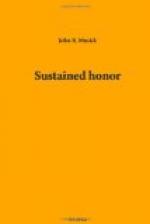While Perry was defeating the enemy on Lake Erie, and the Johnson brothers were defeating Proctor and slaying Tecumseh, the discontent which that redoubtable chief had stirred up in the South was beginning to have its effect among the Creeks. On August 30, 1813, they attacked Fort Mimms, which they set on fire and captured, massacring all but twenty out of four hundred men, women and children. The British agent at Pensacola, it is said, had offered five dollars each for scalps, and many of the savages carried the scalps of women and children there to claim their reward.
A cry for help went northward and the brave Tennesseeans flew to the relief of their neighbors. General Andrew Jackson, military commander of that region, was disabled by a wound received from a brilliant but brutal ruffian named Thomas H. Benton, who was afterward United States Senator from Missouri.
Late in September, Colonel John Coffee, at the head of five hundred cavalry, hurried to the Creek frontier. He rendezvoused at Fayetteville, where Jackson joined him early in October. On the 3d, Coffee attacked the Indians at Tallahatchee (near Jacksonville, Benton county, Alabama) and killed two hundred warriors;—not a warrior escaped. On the 8th of November, Jackson defeated the Indians with great slaughter at Talladega. Late in November, General Floyd with nine hundred Georgians and four hundred friendly Indians attacked the hostile savages at Autossee and drove them from the holy ground.
Weatherford, the Tecumseh of the South, was attacked, on the 23d of November, at Econachaca. Weatherford was defeated and escaped by leaping his horse from a precipice into the river and swimming to the other side.
On January 21, 1814, General Jackson was fiercely attacked by the Creeks at Emucfau on the west bank of the Tallapoosa River. Though he repulsed the Indians, he thought it best to retire from the field.
The Creeks were gathered in great numbers at the “Horse-shoe Bend” of the Tallapoosa. A strong breastwork, composed mostly of hickory logs, was built across the neck of the peninsula. The Indians had great stores of provisions and supplies at this place.
On the 27th of March, the Americans, led by Sam Houston, stormed this fort and routed the Indians, whom they shot down like wild beasts. The power and spirit of the Creeks was broken, and even the haughty Weatherford sued for peace. Save the trouble caused by the Spanish and British, the war in the South was practically ended.
Fernando, who was still with the northern army, had been shifted about so much, that he had received but one or two letters from home. He had participated in the affair at Black Rock, had seen Buffalo burned, and while lying in camp near the ruins, learned of the ravages of the enemy on the Delaware and Chesapeake bays. As yet the British, perhaps out of respect for the Peace Party, had done little damage to the coast of New England. Fernando often thought of the Maryland Coast, of Baltimore and Mariana, and wondered if she were there yet, in the great, white stone house on the hill.




